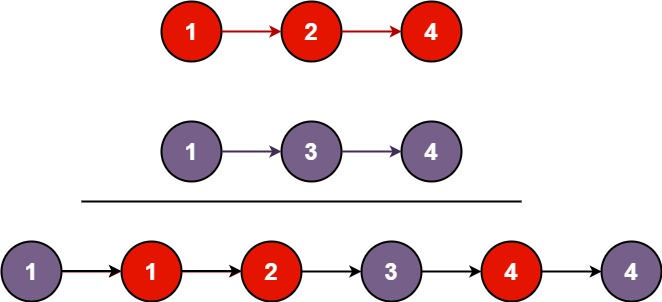将两个升序链表合并为一个新的 升序 链表并返回。新链表是通过拼接给定的两个链表的所有节点组成的。
示例 1:
输入:l1 = [1,2,4], l2 = [1,3,4]
输出:[1,1,2,3,4,4]
示例 2:
输入:l1 = [], l2 = []
输出:[]
示例 3:
输入:l1 = [], l2 = [0]
输出:[0]
提示:
两个链表的节点数目范围是 [0, 50]
-100 <= Node.val <= 100
l1 和 l2 均按 非递减顺序 排列
递归
class Solution {/**因为排好序所以逐一比较就行,当list1.val < list2.val 就递归处理list1.next与list2,然后返回list1即可,反之同理*/public ListNode mergeTwoLists(ListNode list1, ListNode list2) {if (list1 == null) return list2;if (list2 == null) return list1;if (list1.val < list2.val) {list1.next = mergeTwoLists(list1.next,list2);return list1;}list2.next = mergeTwoLists(list2.next,list1);return list2;}}
迭代
class Solution {/**因为排好序所以逐一比较就行,当list1.val < list2.val 就让cur.next指向它,当两个链表有一个为null时就退出循环,cur.next指向不是null的哪一个链表(如果都是null,无所谓指向哪一个)*/public ListNode mergeTwoLists(ListNode list1, ListNode list2) {ListNode dummy = new ListNode(0);ListNode cur = dummy;while (list1 != null && list2 != null) {if (list1.val < list2.val) {cur.next = list1;list1 = list1.next;} else {cur.next = list2;list2 = list2.next;}cur = cur.next;}cur.next = list1 == null ? list2 : list1;return dummy.next;}}class Solution {/**因为排好序所以逐一比较就行,当list1.val < list2.val 就让cur.next指向它,当两个链表有一个为null时就退出循环,cur.next指向不是null的哪一个链表(如果都是null,无所谓指向哪一个)*/public ListNode mergeTwoLists(ListNode list1, ListNode list2) {ListNode dummy = new ListNode(0);ListNode cur = dummy;while (list1 != null || list2 != null) {if (list1 == null && list2 != null) {cur.next = list2;list2 = list2.next;}else if (list2 == null && list1 != null) {cur.next = list1;list1 = list1.next;}else if (list1.val < list2.val) {cur.next = list1;list1 = list1.next;}else {cur.next = list2;list2 = list2.next;}cur = cur.next;}return dummy.next;}}

